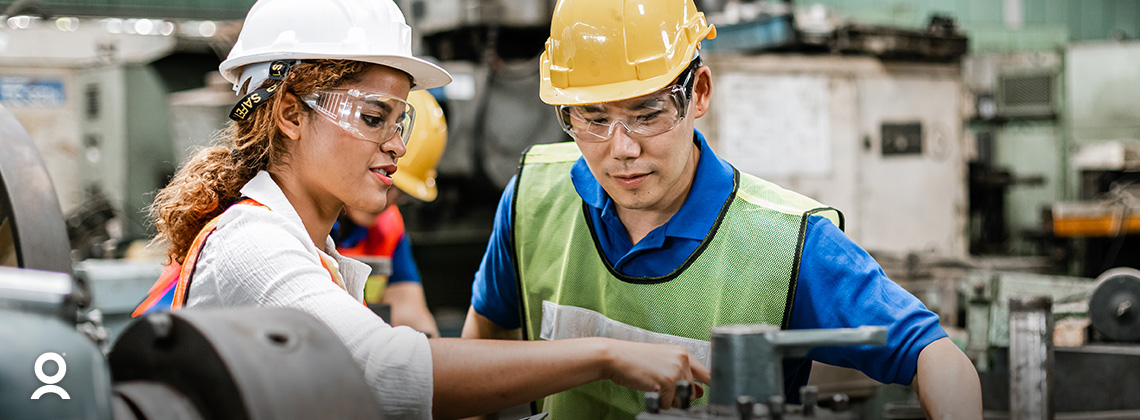Three Trends Facing Manufacturing’s Challenging Labor Market

A version of this article was previously published on DPAOntheNet.net.
Labor shortages are a continual problem in manufacturing. By 2030, estimates predict a shortage of 2.1 million workers. To retain and recruit vital talent, manufacturers must adapt to these conditions or risk becoming obsolete.
As other industries have done, manufacturing must explore using technological innovation through data and connectivity to support the changing needs of workers. Digitalized smart factories are the latest technology wave changing manufacturing operations today, but those same advantages from digital innovation can be applied to workforce management.
Here are three emerging trends ensuring that manufacturing keeps pace with employee expectations and attracting talent back to the production line.
Trend No. 1 – Accelerating Smart Factory Initiatives to Power People-Focused Outcomes
Modern organizations need to invest in their workforce to create a positive employee experience, not only to retain existing employees but to attract prospective workers. This goes a long way toward making your organization an employer of choice, the type of place workers want to be.
Much has been written about how smart factories can improve efficiency, optimize production, and streamline operating procedures, but not much innovation has yet been applied toward supporting workers themselves. They require digital solutions that can pull people, technology, and processes together to deliver beyond productivity and dramatically improve the whole employee experience.
Teams must have access to the information they need to perform at their best, plus just-in-time training and real-time scheduling reminders, which helps them feel supported and engaged as valued colleagues—not just as another set of machines. A modern workforce management system analyzes everyday employee data to better understand the workforce’s productivity level, needs, and challenges. Just as smart factory technologies impact the production line, using smart workforce management technologies gives manufacturers better visibility into their employees and makes it easy to respond to them in timely and impactful ways.
Trend No. 2 – Adjusting Operations and Supply Chains
The aftermath of the COVID-19 pandemic has disrupted the usual cycles of supply and demand, production, and distribution. In addition, fluctuating numbers of key workers due to illness and the so-called Great Resignation have made it difficult to keep production and transport on schedule. In response, 75% of manufacturers worldwide plan to fight this by reshoring (bringing operations closer together geographically) and localizing supply lines.
Organizations must remain agile and responsive to address these issues. Such agility can only be achieved when teams are ready and supported to pivot at a moment’s notice. Today’s employees value flexibility and open communication, to the extent that 39% of employees and 44% of managers report that their companies do not offer flexible scheduling. It is essential that when employees are asked to adapt, employers offer quid pro quo in terms of enhanced scheduling and communication channels.
Digital communication abilities allow for real-time process changes and streamlined, two-way dialogue with workers—even with the many who are “deskless.” And with advanced analytics in labor forecasting, labor can be optimized to meet demand in a way that is good for both businesses and employees.
Trend No. 3 – Brain Drain and Skill Deficits
Manufacturing has had a consistent issue with retaining talent, and the workers who remain often lack the skills the industry needs most. Alongside labor shortages, closing the skills gap is a seemingly constant challenge in this industry. As the talent pool shrinks, 57% of manufacturing leaders say they lack the skilled workers to support plans to implement smart manufacturing.
With digital workforce management tools, new training materials can be provided to employees at any time, sent directly to their personal devices. Whether it be brand new workers acquiring novel skills or seasoned professionals looking for a tune-up, these in-the-moment micro-training opportunities provide workers with the tools to troubleshoot any obstacles that may interfere with their work.
A Revolution in the Deskless Experience
Amid so many challenges, one of the greatest obstacles to delivering heightened employee experiences to manufacturing workers is that they are often dispersed and deskless. For too long, there has been an experience gap between those in office roles and those providing vital deskless services. Deskless workers need a different, more creative approach to ensure they are fully engaged.
This is where digital technologies are closing the experience gap. As manufacturers progress toward smart manufacturing, the opportunities digitalization can bring to workers must be integrated as part of a strategy of holistic innovation. The future is created where digital technologies meet human talent—no matter the industry or workplace.
Need more information on how modern workforce management can transform manufacturing to keep up with today’s technological demands? Take a look at our Manufacturing Industry page to see what WorkForce Software can do for you.
Subscribe to The WorkForce Blog
Learn the art and science of maintaining productive, happy, engaged employees.
Discover More
2024 Gartner® Market Guide for Workforce Management Applications
The 2024 Gartner® Market Guide to Workforce Management Applications offers crucial insights and strategic planning assumptions decision-makers should consider.
Prove It First: The Tough Questions to Ask Your Technology Vendors
Get the most out of your software evaluation demonstration using our top 10 tips.
California Expands Employee Leave Entitlements…Again
California adds three new employee leave benefits that will begin January 1, 2025.



